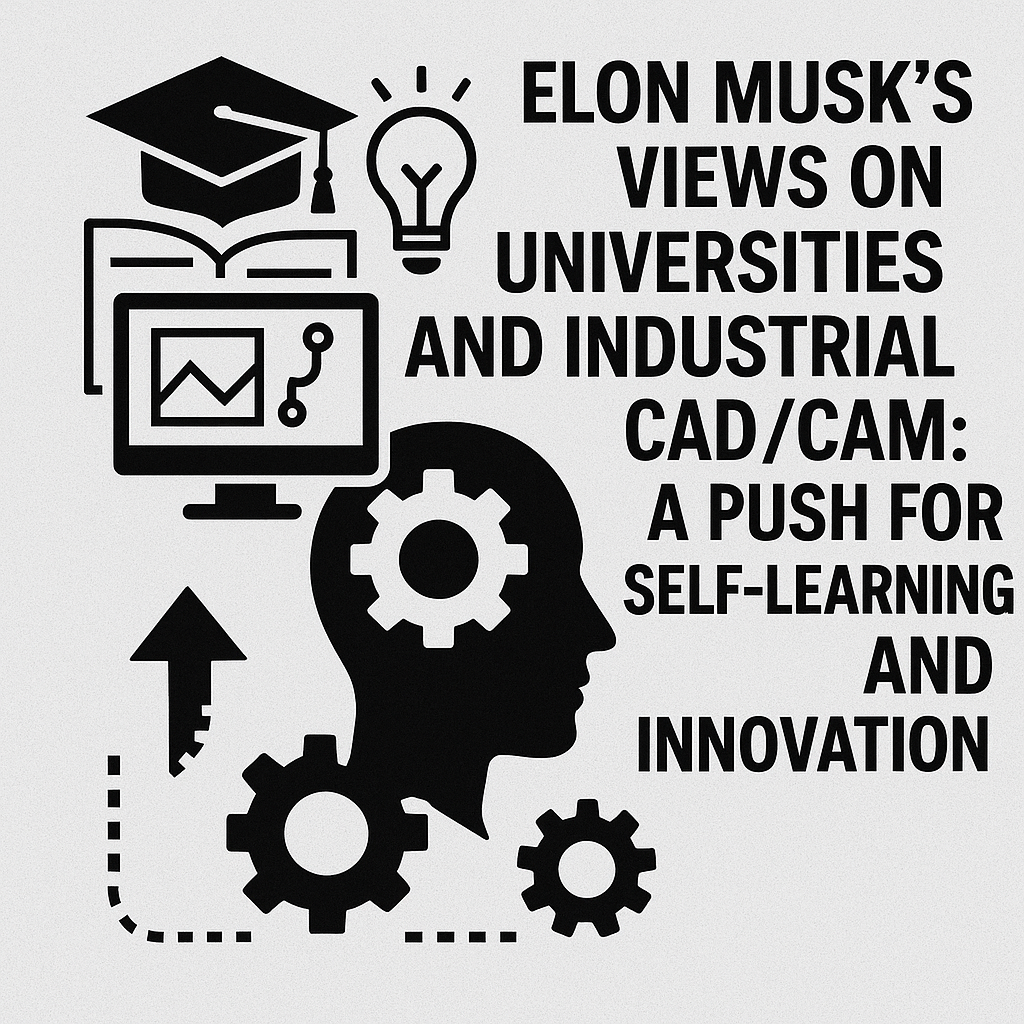
Elon Musk’s Views on Universities and Industrial CAD/CAM: A Push for Self-Learning and Innovation
In today’s rapidly evolving tech landscape, aspiring engineers and designers often grapple with the choice between formal education in fields like mechatronics and self-taught paths, especially when it comes to mastering tools like Computer-Aided Design (CAD) and Computer-Aided Manufacturing (CAM). Elon Musk, the visionary behind companies like Tesla, SpaceX, and xAI, has strong opinions on this debate. Drawing from his public statements and experiences, Musk champions self-directed learning over traditional university systems while advocating for revolutionary changes in industrial CAD/CAM processes.
Musk’s Critique of Universities: “Social Clubs” Rather Than Essential Learning Hubs
In this post Elon Musk has been vocal about his skepticism toward higher education, viewing universities as outdated institutions that prioritize social experiences over practical knowledge. He famously stated that colleges are “basically for fun and to prove you can complete chores, but they’re not for learning.” Musk argues that with the abundance of free online resources, formal degrees are unnecessary for acquiring skills. “You can learn anything you want for free,” he has emphasized, pointing out that the internet democratizes education far better than brick-and-mortar schools.
This view stems from Musk’s own journey. He dropped out of a PhD program at Stanford after just two days, opting instead to build companies like Zip2 and PayPal through self-study and hands-on experimentation. As a child, he taught himself programming by devouring books and coding late into the night, completing what would be a university-level course in days. Musk extends this philosophy to his hiring practices at SpaceX and Tesla, where he doesn’t require college degrees. Instead, he values proven ability, stating, “A college degree is not required at all.” As stated in this post, he has criticized elite universities for producing graduates lacking real-world engineering skills, insisting companies must “test people independently for engineering abilities.”
Musk’s disdain goes deeper, targeting what he calls the “woke mind virus” infiltrating education. He believes modern curricula promote anti-meritocratic ideologies, diversity, equity, and inclusion (DEI) initiatives, and anti-American sentiments at the expense of core skills. He has lambasted the U.S. Department of Education for wasting billions on bureaucracy and DEI grants rather than improving outcomes, noting that student performance hasn’t risen despite massive spending increases since its creation in 1980. Musk supports abolishing the department entirely, arguing it hinders true progress. In his view, American education has been “broken for a quarter century,” with bloated administrative staff diverting resources from actual teaching
For Musk, practical, curiosity-driven learning trumps formal academia. He encourages dismantling objects—like engines or toasters—to understand physics and engineering intuitively. He even compares learning to drive in the AI era to riding a horse: useful but optional, as technology advances. At xAI, he eliminated the distinction between “researchers” and “engineers,” calling everyone “engineers” to reject academic hierarchies and focus on accountability.
Bridging the Gap: Implications for Mechatronics and CAD/CAM Learners
While Musk downplays formal education, he is deeply involved in industrial design and manufacturing, particularly CAD/CAM technologies. He personally engages in CAD work at SpaceX and Tesla, emphasizing that “manufacturing at volume is mostly a software problem.” Musk believes design is “overrated” compared to manufacturing, where the real challenges lie—often requiring 1,000% to 10,000% more effort to scale production.
He has pushed for breakthroughs in CAD/CAM interfaces, demonstrating a hand-gesture system inspired by Iron Man’s holographic designs. In 2013, Musk showcased a Leap Motion controller integrated with Siemens NX software at SpaceX, allowing engineers to manipulate 3D models without a mouse or keyboard. “We’re on the verge of a major breakthrough in design and manufacturing,” he said, envisioning seamless mind-to-machine transfers. This aligns with his broader algorithm for manufacturing: simplify, optimize, accelerate, automate last—warning against premature automation.
Musk credits CAD advancements and 3D printing for propelling manufacturing forward, much like software has revolutionized other industries. At Tesla and SpaceX, he demonstrates “new thinking” to slash costs, treating production as a software-driven puzzle. Critics note he isn’t a traditional engineer and relies on teams, but Musk’s hands-on approach—using tools like CATIA for aerospace—shows his commitment to evolving CAD/CAM beyond conventional methods.
Musk on Industrial CAD/CAM: Innovation Over Tradition
Musk’s philosophy suggests that for fields like mechatronics—which blends mechanics, electronics, and computing for CAD/CAM applications—self-teaching with real-world projects is superior to university paths. He learned rocket science autodidactically for SpaceX, achieving more “cutting-edge research” than university labs without the academic label. Tools like Starlink further enable global access to education, potentially outpacing traditional systems in underserved areas.
In an era where AI like Grok accelerates learning, Musk predicts even greater shifts. For aspiring CAD/CAM professionals, his message is clear: Focus on practical innovation, question outdated systems, and embrace self-directed paths. Whether you’re building robots or designing EVs, Musk’s blueprint prioritizes action over accreditation.
